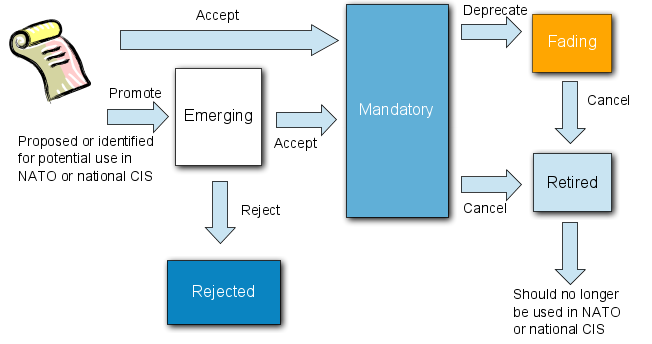Chapter 5. Organization of the Information
5.1. NISP Structure Drivers
4. In general, systems development approaches suggest a clean line of reasoning from requirements capturing to architecture, to design and build via testing to implementation and utilization and finally to retirement.
5. The structure of the NISP is determined by several factors:
-
Ease of use for the users of the NISP;
-
Nature of standards and profiles.
6. The NISP contains three volumes:
7. Volume 1 - Introduction and Management: This volume provides the management framework for the development and configuration control of the NISP and includes the general management procedures for the application of the NISP in NATO C3 systems development and the process for handling Request for Change Proposals (RFCP).
8. Volume 2 - Agreed Standards: This volume lists agreed interoperability standards. These should support NATO and National systems today and new systems actually under procurement or specification.
9. Volume 3 - Profiles: This Volume provides Interoperability Profiles and guidance on their development. Interoperability Profiles provide collections of standards and (sub)profiles for different military CIS. Interoperability Profiles identify essential profile elements including:
-
Capability Requirements and other NAF architectural views,
-
characteristic protocols,
-
implementation options,
-
technical standards,
-
Service Interoperability Points, and
-
the relationship with other profiles such as the system profile to which an application belongs.
10. These profiles will be referenced in the NISP for specified NATO Common Funded Systems or Capability Packages and may include descriptions of interfaces to National Systems where appropriate.
11. Technology standards are subjected to a life-cycle. This life-cycle is used to refine the categorization of standards within volumes 2 and 3 and is a key to providing guidance on the use of standards in the development and transition of NATO CIS. The NISP has adopted the five categories of standards in the life-cycle shown below in Figure 5.1.

12. Proposed standards can be accepted as emerging standards in order to follow their developments and decide if they can be promoted to mandatory standards. In some cases proposed standards can be readily accepted as mandatory standards. Containment standards have been classified as either fading or retired.
13. A short description of each category is described below:
-
Mandatory: A standard is considered mandatory if it is mature enough to be used immediately. This means that it may both be applied within existing systems and in future(mid-term) planned systems. NATO STANAG's that are promulgated shall be considered mandatory.
-
Emerging: A standard is considered emerging if it is sufficiently mature to be used within the current or next planned systems. Some emerging standards may not be immediately suitable. For example, commercial companies may not support the standards or the underlying technology is not considered mature. NATO STANAG's that are not promulgated, superseded or cancelled shall be considered emerging.
-
Fading: A standard is considered fading if the standard is still applicable for existing systems; however, it is becoming obsolete, or will be replaced by a newer version, or another standard is being proposed. Except for legacy systems or interoperability with legacy systems, the standard may not be used.
-
Retired: A standard is considered retired if the standard has been used in the past and is not applicable to existing CIS systems. NATO STANAG's that are superseded or cancelled shall be considered retired.
-
Rejected: A standard is considered rejected if, while it was still emerging, it is considered unsuitable for use within NATO.